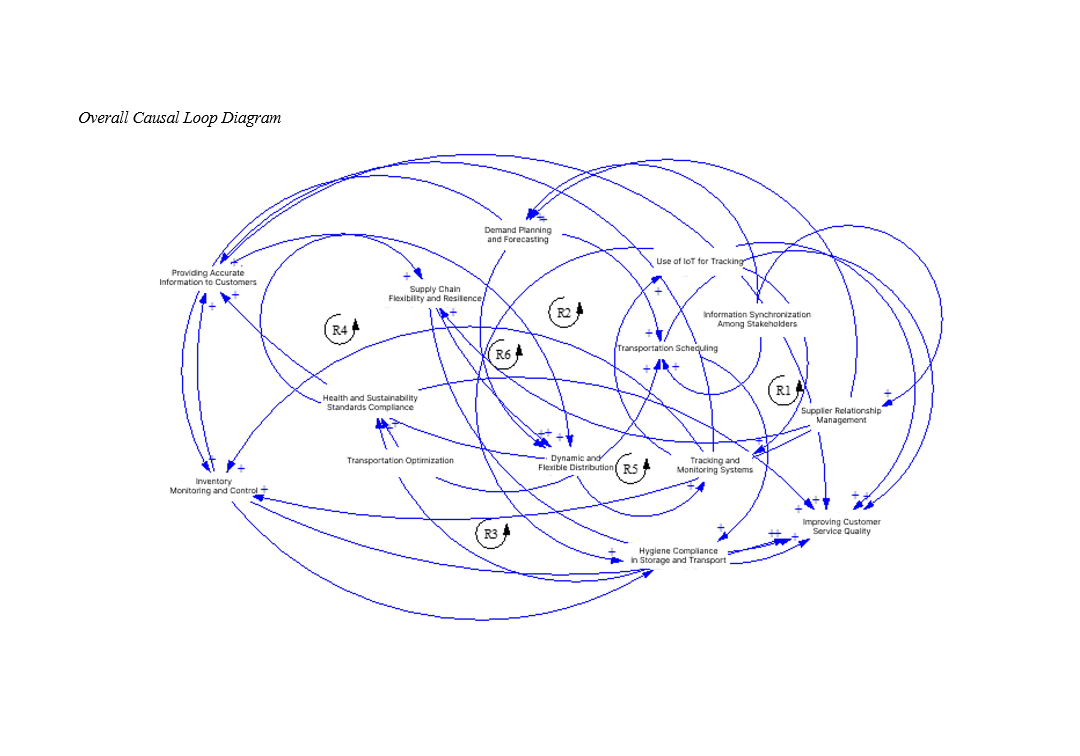Dynamic Modeling of Operational Synchronization for Pharmaceutical Distribution Centers in Logistics Services Using the System Dynamics Approach
Keywords:
Operational synchronization, pharmaceutical distribution, logistics services, system dynamics, service qualityAbstract
In recent years, the expansion of networking capabilities within the economic system and the ability to create smart, flexible markets with high efficiency and low cost have provided an exceptional opportunity for service-providing companies. These companies can, through participation in value chain management, transform supply chain architecture, thereby generating new markets and fresh demands for services centered on integration and coordination within the logistics system. The existence of a comprehensive, sustainable, and reliable logistics network enables the development of a range of small and medium-sized enterprises (SMEs) within the framework of e-commerce—enterprises that, in the absence of such a network, would lack sufficient economic justification due to limited market size. This article examines and analyzes the topic of dynamic modeling of operational synchronization for pharmaceutical distribution centers in logistics services using the system dynamics approach. The results indicate that supply chain resilience functions as a critical factor in responding to crises (such as pandemics, logistical disruptions, or sudden demand fluctuations) and prevents the degradation of service quality. The implementation of dynamic distribution leveraging advanced technologies, including artificial intelligence (AI) and the Internet of Things (IoT), enables rapid and intelligent decision-making in the face of disruptions. The increase in customer satisfaction within this loop creates positive pressure for the continuous improvement of infrastructure and processes, thereby strengthening the cycle of organizational learning and improvement.
References
Abdollahi, A., Ebrahimpour, M., Ramazanian, M. R., & Moradi, M. (2024). Intelligent Distributed Supply Chain Management in the Pharmaceutical Industry. Journal of Strategic Management Studies, 14(56), 141-167. https://www.smsjournal.ir/article_185993.html
Abdul Rahman, N. S. F., Karim, N. H., Md Hanafiah, R., Abdul Hamid, S., & Mohammed, A. (2023). Decision analysis of warehouse productivity performance indicators to enhance logistics operational efficiency. International Journal of Productivity and Performance Management, 72(4), 962-985. https://doi.org/10.1108/IJPPM-06-2021-0373
Ajali, M. (2021). Supply Chain Management and Logistics with Intelligent Systems. https://civilica.com/doc/1383964/
Akbar, M. A., Leiva, V., Rafi, S., Qadri, S. F., Mahmood, S., & Alsanad, A. (2022). Towards roadmap to implement blockchain in healthcare systems based on a maturity model. Journal of Software: Evolution and Process. https://doi.org/10.1002/smr.2500
Akbarpour, M., Torabi, S. A., & Ghavamifar, A. (2020). Designing an integrated pharmaceutical relief chain network under demand uncertainty. Transportation Research Part E: Logistics and Transportation Review, 136, 101867. https://doi.org/10.1016/j.tre.2020.101867
Al Abbadi, M. S. M., Qureshi, M. I., Yasir, M., & Khan, N. (2021). Assessing challenges and opportunities in optimizing logistics and supply chain performance in Oman. Academy of Entrepreneurship Journal, 27, 1-22. https://www.abacademies.org/articles/assessing-challenges-and-opportunities-in-optimizing-logistics-and-supply-chain-performance-in-oman-11574.html
Al Jabri, A. M. A., Slimi, Z., Al Yaqoopi, H. H., & Mehmet, U. (2021). Logistic companies in Oman: Role in Islamic Marketing. Journal of Islamic Marketing, 13(1), 81-99. https://mail.ejbmr.org/index.php/ejbmr/article/view/1127
Ala, A., Yazdani, M., Ahmadi, A., Poorianasab, M. Y. N., & Attari, M. (2023). An efficient healthcare chain design for resolving the patient scheduling problem: queuing theory and MILP-ASA optimization approach. Annals of Operations Research. https://doi.org/10.1007/s10479-023-05287-5
Albukhitan, S. (2020). Developing digital transformation strategy for manufacturing. Procedia Computer Science, 170, 666-671. https://doi.org/10.1016/j.procs.2020.03.173
Aldrighetti, R., Battini, D., & Ivanov, D. (2023). Efficient resilience portfolio design in the supply chain with consideration of preparedness and recovery investments. Omega, 117, 102841. https://doi.org/10.1016/j.omega.2023.102841
Aslam, H., Khan, A. Q., Rashid, K., & Rehman, S. u. (2020). Achieving supply chain resilience: the role of supply chain ambidexterity and supply chain agility. Journal of Manufacturing Technology Management, 31(6), 1185-1204. https://doi.org/10.1108/JMTM-07-2019-0263
Asmahan Al, Z., & Asad, U. (2024). The Effectiveness of Logistics Services on Firms' Performances - A Literature Review. Journal of International Trade, Logistics and Law, 10(1), 58-67. https://doi.org/10.54536/ajebi.v3i1.1744
Augustine, A., & Fulghum, S. (2019). Journal of Supply Chain Management, Logistics and Procurement. 1(4), 326-333. https://doi.org/10.69554/LWIT2290
Babai, M. Z., Ivanov, D., & Kwon, O. K. (2023). Optimal ordering quantity under stochastic time-dependent price and demand with a supply disruption: A solution based on the change of measure technique. Omega, 116, 102817. https://doi.org/10.1016/j.omega.2022.102817
Bajec, P., & Tuljak-Suban, D. (2022). A strategic approach for promoting sustainable crowdshipping in last-mile deliveries. Sustainability, 14(20). https://doi.org/10.3390/su142013508
Baldoni, S., Amenta, F., & Ricci, G. (2019). Telepharmacy Services: Present Status and Future Perspectives: A Review. Medicina, 55(7), 327. https://doi.org/10.3390/medicina55070327
Barnabas Bitta, M. (2024). SYNCHRONIZATION OF LOGISTICS DRIVERS FOR OPTIMIZING SUPPLY CHAIN OPERATIONS IN TANZANIA: A DESCRIPTIVE SURVEY. Journal of International Trade, Logistics and Law, 10(1), 58-67. https://www.jital.org/index.php/index/oai?verb=ListRecords&metadataPrefix=oai_dc
Bharadwaj, A. (2023). IT Capabilities and Firm Performance: A Contingency Theory of Information Technology. European Journal of Information Systems, 26, 273-289. https://www.scirp.org/reference/referencespapers?referenceid=3571490https://www.scirp.org/reference/referencespapers?referenceid=3571490
Brusset, X., Davari, M., Kinra, A., & La Torre, D. (2022). Modelling ripple effect propagation and global supply chain workforce productivity impacts in pandemic disruptions. International Journal of Production Research. https://doi.org/10.1080/00207543.2022.2126021
Derakhshi, J. (2020). Development of a Causal Model of Influencing Factors on Supply Chain Resilience. Scientific Journal of Supply Chain Management. https://scmj.ihu.ac.ir/article_205799.html
Faramarz Noori, J. G. N. (2019). Robust-Stochastic Optimization Method in Designing a Pharmaceutical Supply Chain Network Under Uncertainty and Providing Discounts on Raw Material Purchases. Journal of Modeling in Engineering, 17(58). https://modelling.semnan.ac.ir/article_4015.html
Foroughi, D., & Kia, H. R. (2022). Designing a Pharmaceutical Supply Chain Network Under Uncertainty and Reverse Logistics. Transportation Research Journal. https://www.trijournal.ir/article_149002.html
Lotfi Zadeh, F., & Ehsani, E. (2021). Investigating the Impact of Logistics Service Quality Based on Logistics Procurement Capabilities on Customer Satisfaction.
Moghadaspour, B. (2020). Presenting a Closed-Loop Supply Chain Model Considering Third-Party Factors. Scientific Journal of Supply Chain Management. https://scmj.ihu.ac.ir/article_205464.html
Mohghar, A., Mansouri, T., & Hadadi, S. (2024). A Model for Outsourcing Reverse Logistics Planning Based on Fuzzy-Intuitive Analysis Considering Artificial Intelligence Methods. Perspective of Industrial Management, 14(2), 136-152. https://civilica.com/doc/2017727/
Nooraniyan, M., & Saqaeian Nejad Isfahani, S. (2024). Estimating the Pharmaceutical Supply Chain Management Model for Medical Consumables Using Factor Analysis Method. Modern Medical Information, 10(1), 98-109. http://jmis.hums.ac.ir/article-1-499-fa.html
Reza Jalil, E., Asghari Zadeh, A., & Kazemi, A. (2021). A Model for Coordinating the Service Supply Chain. Strategic Management Studies, 47, 63-78. https://www.smsjournal.ir/article_125783_86aa6bc3d97b419f6bd3cc2b2fb003d9.pdf
Sami'i, H. A., Mehrabian, A., Ashrafi, M., & Khamaki, A. (2023). Identifying Benefits and Costs of Sustainable Supply Chain in Uncertainty Conditions in Manufacturing Companies. Journal of Value Creation in Business Management, 3(3), 41-64. https://www.jvcbm.ir/article_178979.html

Downloads
Published
Submitted
Revised
Accepted
Issue
Section
License
Copyright (c) 2025 Masoomeh Omidi Eslami (Author); Ahmad Reza Kasraee; Hassan Mehrmanesh (Author)

This work is licensed under a Creative Commons Attribution-NonCommercial 4.0 International License.









